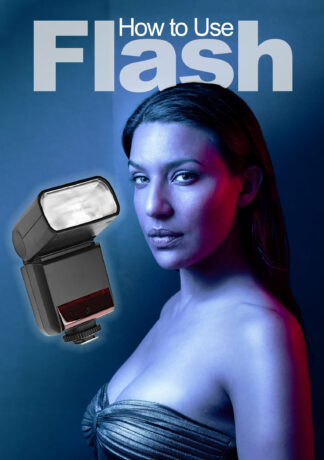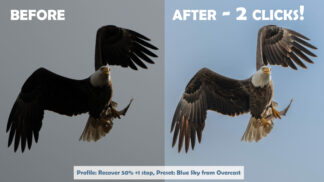The viewfinder is the window you put your eye to before taking a picture. Many modern cameras don’t have a proper viewfinder at all, instead requiring you to use the large LCD screen on the back of the camera to compose your shot. That’s fine; you don’t need a viewfinder for casual photography, as demonstrated by the popularity of smartphone photography.
Do You Need a Viewfinder?
Viewfinders are useful for serious photographers and anyone shooting sports or wildlife, however. First, they block out sunlight and distractions, making it easier to concentrate on your composition. If you’re using a telephoto lens (as you would be for sports and wildlife), they make it much easier to hold your camera steady and pinpoint a distant subject. This picture shows the Sony a5100 (which has an LCD display but not a viewfinder) on the left and the slightly more expensive Sony a6000, which has a viewfinder in the upper-left corner.
Optical vs. Electronic Viewfinders (EVFs)
Modern cameras have one of two types of viewfinders, and this can have a significant impact on your photography:
- Optical viewfinders. All DSLRs (except the Sony SLT cameras) have an optical viewfinder, the basic design of which dates back to the late 1800s. It really is a primitive design; the camera inserts a mirror between your lens and sensor and it bounces the light into a prism which then bounces the light into your eye. This guarantees that the viewfinder shows what your sensor will see, because it’s exactly the same light.
- Electronic viewfinders (EVFs). Mirrorless cameras process the data from the digital sensor and display an image on either a large display on the back of the camera or a small, simulated viewfinder. This means that you can see the effects of exposure compensation. The camera can also supplement the image with histograms, focusing peaking, and other useful data. Because the camera has to process the signal, there is always a very short delay of a few milliseconds. Also, the digital display is less sharp than the real world.
The following three figures show the Canon 70D’s optical viewfinder (first) followed by two different views of the Fujifilm X-T1’s EVF. As you can see, the X-T1’s EVF is bigger and brighter, shows far more information, and overall looks far more modern and polished. EVFs allow for a much more complex display while looking through the viewfinder, because the camera can add anything it wants over your view, almost like the heads-up display from the Terminator or Robocop movies. For example, the EVF can:
EVFs allow for a much more complex display while looking through the viewfinder, because the camera can add anything it wants over your view, almost like the heads-up display from the Terminator or Robocop movies. For example, the EVF can:
- Display a histogram while you look through the lens.
- Show you the actual exposure that the picture will have, including any exposure compensation you’ve dialed in.
- Allow you to monitor video recording using the viewfinder.
- Allow you to review the last photo without removing your eye from the viewfinder.
- Reduce or eliminate the viewfinder blackout period DSLRs experience when taking a picture.
- Provide a depth-of-field preview that doesn’t darken the viewfinder. Depth-of-field preview on an optical viewfinder is less useful because the viewfinder gets very dark, making it difficult to see.
- Provide 100% viewfinder coverage. Optical viewfinders on less expensive cameras tend to hide very small portions of the edges of the frame.
High-quality electronic viewfinders (such as those in the Olympus E-M1, Fujifilm X-T1, and Panasonic GH4) are superior to optical viewfinders for most types of photography. They’re better than real life, allowing you to see in the dark, view the exact effect of any exposure compensation, preview filters (such as seeing in black-and-white), and zoom in for precise focusing. They don’t go dark when you take a picture, and you don’t have to take your eye away from the viewfinder to review your last shot. You can even use the viewfinder while recording video. Optical viewfinders seem outdated in comparison (and they are), but they operate at the speed of light, so there’s no lag. That makes them superior for sports and wildlife. They also don’t require any battery power, so while a DSLR battery can last a week on vacation, my mirrorless cameras with electronic viewfinders are out of batteries in 4-6 hours. For true DSLRs with optical viewfinders, you can realize most of these benefits by switching your camera to live view mode and looking at the display on the back of the camera. Of course, this requires you to hold the camera away from your face, so it is not a perfect substitute for an EVF. DSLR live view displays also tend to be slower and more laggy than a mirrorless camera’s EVF. In practical use, EVFs have some disadvantages when compared to an optical viewfinder. Specifically, the lag, refresh rate, and sharpness (discussed in the next section) are never as good as those of an optical viewfinder. They also consume far more batteries than an optical viewfinder does. In my opinion, EVFs are so great that they’re definitely the future. Whether they’re right for you, right now, though, depends on your subject. You certainly don’t need an EVF, though they can be nice to have. Right now, EVFs are not the ideal choice if you shoot action. This, combined with the fact that mirrorless cameras have slower focusing systems and fewer telephoto lenses, prevents me from recommending mirrorless cameras for sports and wildlife. However, that doesn’t stop many photographers from taking great action shots with EVF cameras; they just need to anticipate the action a bit more and perhaps snap a few more frames.
EVF Lag, Refresh Rate, and Sharpness
All EVFs are not created equal. Better quality EVFs look nicer, allow for more precise manual focusing, and enable you to better track moving subjects. The three most important criteria for evaluating an EVF are:
- Lag. This is the delay between when an event occurs in the real world and the time you see it on the viewfinder. All EVFs have some lag because the camera has to process the data from the sensor, but a shorter lag is better. Longer lags can be quite frustrating to use with moving subjects. As an example of the variation in lag, our recent test found the Fujifilm X-T1 had a lag of .005 seconds, the Olympus E-M10 had a lag of .025 seconds, and the Sony a6000 had a lag of 0.046 seconds. In low light, lag can increase substantially.
- Refresh rate. Higher refresh rates cause movements in the EVF to be smoother. For example, if you pan the camera sideways with a slow viewfinder, the pan will seem jagged instead of smooth. EVFs measure their refresh rate in frames per second (fps). Fast EVFs, like the Olympus E-M10, have a refresh rate of 120 fps. Slower EVFs might have a 30 fps refresh rate, similar to that of a television.
- Resolution. The more pixels in the viewfinder, the sharper the screen. Sharper screens look more like the real world, and can help make manual focusing easier. For example, Olympus gave the high-end E-M1 a 2.36 million-dot display, whereas it gave the lower-end E-M10 only a 1.44 million-dot display.
A few years ago, lag, refresh rate, and resolution problems could often make EVFs almost unusable on mirrorless cameras. However, all modern mirrorless cameras have EVFs that won’t interfere with the picture-taking process. If you shoot action, however, it might be worth investing in a camera with a higher quality EVF. Specifically, the Panasonic GH4, Olympus E-M1, and Fujifilm X-T1 have the greatest viewfinders available.
EVFs on Sony SLT Cameras
Sony has been pioneering the use of electronic viewfinders (EVFs) with their SLT/DSLRs (though true DSLRs don’t have EVFs, they otherwise function like DSLRs). In theory, this provides the best of both worlds: the phase-detect autofocus capabilities of a DSLR and the EVF of a mirrorless camera. The SLT design reduces the total light reaching the camera’s sensor by one-eighth to one-third, requiring cameras with an EVF to use a higher ISO setting or a longer shutter speed to achieve the same exposure. If you want a DSLR-like design with an EVF, your current options are limited to the Sony a58, a77, and a99.
Viewfinder Placement
All DSLRs have the viewfinder in the upper-middle of the back of the camera because it must be physically aligned with the lens. Mirrorless cameras could theoretically put the viewfinder anywhere, but they generally position it in the upper-middle (like an SLR) or the upper-left (like a viewfinder camera), as shown in the following picture. If you shoot with your right eye, having the viewfinder in the upper-left is more comfortable because it doesn’t require you to press your nose against the camera back. If you shoot with your left eye, the center viewfinder is more comfortable. 





